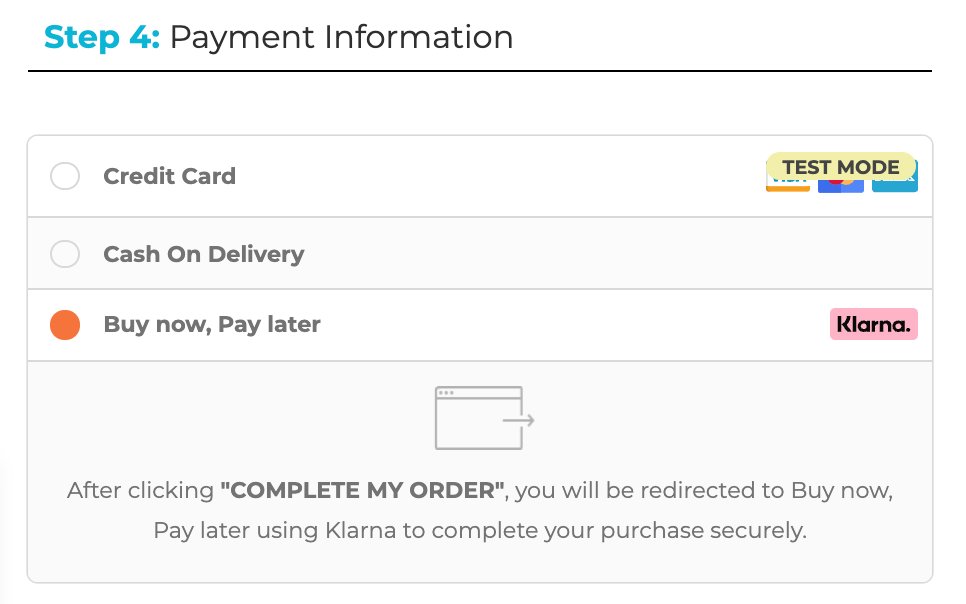Sales Funnels for Beginners: How do they work?
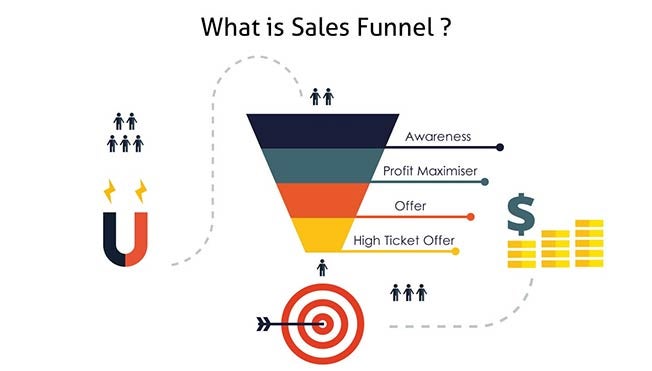
If you have recently started to investigate a little about running your own business online, then you have more than likely run across the term sales funnel.
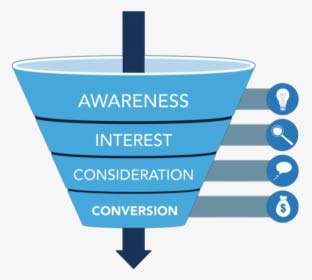
Regardless of the popularity of the term, nobody outside of the digital marketing world seems to completely know or understand what it is and how a sales funnel works. To alleviate your itch, we will address every detail there is to know about sales funnels.
KEY POINTS
- The Definition of a Sales Funnel
- The Purpose of a Sales Funnel: How Do They Work?
- Problems in Your Business That a Sales Funnel Can Solve
- Samples of Sales Funnels in Today’s Industry
- The Science Behind the Stages of a Sales Funnel
- Take Action
The Analogy of a Sales Funnel
A sales funnel is a marketing model that helps you generate leads for your business. Sales funnels exist to help you increase your average order value, this refers to helping you generate income rather than just breaking even.
This marketing term acquires its name due to the shape of the graph in which it is represented. The funnel sale model is represented precisely in the shape of a funnel with the bigger opening being at the top and the narrow end at the bottom.
THE PROBLEM:
Without the appropriate sales funnel, it’s difficult for a business to break even and make enough sales to generate profit.
The biggest reason why your business may not be working as it should because there’s not enough traffic going through your page. Furthermore, it cannot just be any type of traffic, it has to be valuable traffic.
THE SOLUTION:
Create a sales funnel that works for your niche to guide you from the first step to gain some attention, to educating the audience about what you have to offer, and finally to the moment of making a sale.
The appropriate sales funnel will provide your business with much-needed exposure and will guide your audience through the full experience your business has to offer.
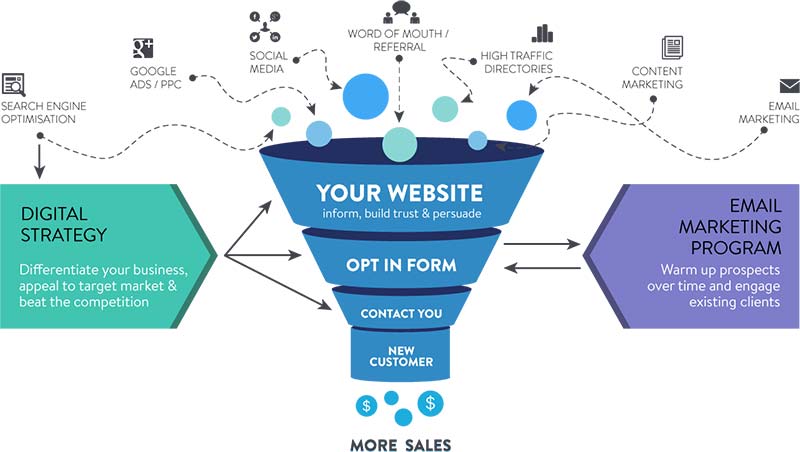
How Do Sales Funnels Work?
You have to think of a sales funnel as if it was a love potion.
The purpose of this love potion is to get as many people as you can to fall in love with your service or product and learn about your business in general so that they may become long-term or recurring lovers, also known as customers.
But a relationship is not something that happens overnight. It has to be carefully looked after and built in stages.
These stages are the parts of the sales funnel that will slowly court your audience into becoming more than just an acquaintance and formalizing a serious relationship.
A sales funnel perfectly expresses the stages of building this relationship with prospective clients to lure them into consummating a buying decision.
But of course, every type of business, product, or service has to take a different approach to fulfill this relationship according to its niche, and that’s exactly why there are so many different types of sales funnels.
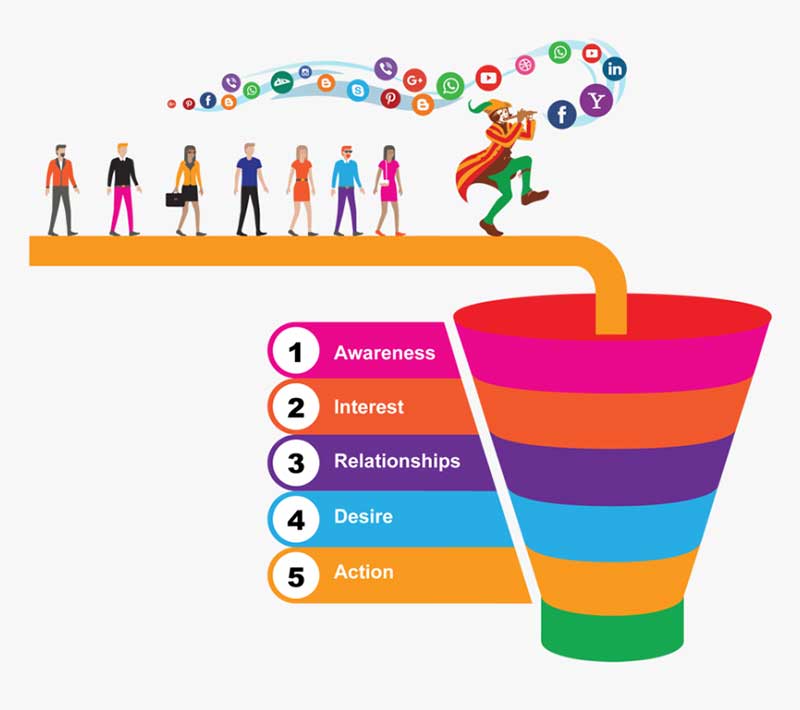
The steps of a sales funnel will guide you to:
- Create engagement with prospective clients.
- Create awareness of your brand, product, or service.
- Generate interest in what you have to offer.
- Educate about how what you are offering solves a problem or fulfills a necessity.
- Make a decision to choose your products or services over other providers.
- Take action to become buyers, users, and consumers.
Sales funnels are not just for online businesses, they can be implemented into any type of business whether it is virtual or physical.
This is because all customers have to go through a process of awareness towards your business so that they can ultimately spend their money on your business and you can begin generating income.
Problems in Your Business That a Sales Funnel Can Solve
If your business just doesn’t seem to be getting the attention it deserves and is not generating sales, there are some mistakes you are most definitely making.
As sales funnels fix very specific problems, you will definitely want to incorporate creating a sales funnel if you have one of the following problems:
Problem No. 1: You are not generating enough traffic
If your online store is not getting exposure or visitors, a sales funnel can give you a strategy to help you generate valuable traffic. The death of any business is a lack of clientele, so if this is your problem, it will need to be addressed in one of the stages of your funnel.
Problem No. 2: You are not generating enough conversions
It may be that your problem is not actually getting visitors. It is absolutely possible for a business to have a lot of traffic, but for that traffic to not be providing a turnaround into profit.
Problem No. 3: You are not getting enough users or subscribers
If your eCommerce business is just not receiving a decent amount of users or subscribers, you may never build an audience to learn about you. This is one of the most common problems that a sales funnel addresses.
If you have any of these problems, there are some very specific mistakes you could be making. To address the root of your problem, ask yourself the following questions:
Issue No. 1: Are you targeting a specific audience? Or are you taking an “anyone and everyone” that comes sort-of-approach?
If not, here is your solution:
While setting up your advertisements, especially on platforms such as Facebook Ads, it’s a common mistake to set it up so that you have the widest possible reach.
Not everyone will be interested in what you have to offer, so study your competition and check what kind of audience and customers they have. Build a demographic based on what you see and only target those who are more likely to be interested in your product or services.
When it comes to your audience you want quality, not quantity. It’s useless to have 1,000 followers on your social media page if none of them are really interested in what you are offering.
Issue No. 2: Are you nurturing your leads and following up with them?
If not, here is your solution:
You can’t just set up an advert and expect the magic to happen. Once you attract users and followers keep them engaged and follow up with them.
How can you do so? Send newsletters, run polls to keep the interaction going, organize contests and address positive and negative reviews if they got to the point of purchasing.
It’s important not to just gain followers, but to keep up with them and make them feel that they are important to you. So important in fact that you keep in touch and offer them something new or innovative to keep them coming back to you for updates themselves.
Not following up with your audience or with leads you have already generated could make or kill your business.
Issue No. 3: Are you offering something that fulfills a need or solves a problem?
If not, here is your solution:
Whatever it is you are trying to monetize has to meet one of three criteria to become successful: to solve a problem, to fulfill a need, or to offer something innovative.
Products and services that offer a solution or fulfill a need will always be fairly easy to sell, but if what you’re offering doesn’t fall under one of these two categories, you will need to get very creative with your marketing campaign.
Issue No. 4:
Are you offering any sales or offers?
If not, here is your solution:
If your audience is just now getting introduced to your business offer, you will have to give them something to incentivize them to try out your product with the hope that will get hooked on it and go back to you for recurring sales or services.
This is especially needed for new businesses. One cannot simply expect users to be convinced to check out your business on their own account, especially if there are little to no reviews about what you are offering, along with a lack of antiquity in the market.
Create marketing campaigns that run by seasons so that you can offer a specific sale or offer per period so that prospective customers feel the urgency to act quickly before the sale ends.
Issue No. 5:
Is your marketing campaign attractive for your audience?
If not, here is your solution:
This is where your business image and branding become a huge asset to your business. Say you are selling The Cullinan Diamond, for example, which is the most expensive diamond in the world worth an estimated $51 million USD.
But your advertisement for the diamond looks like it was made of Paint and it portrays an image that simply doesn’t match the quality of the product.
Then no matter how rare and precious your product is, if your marketing campaign is not attractive, it will never succeed.
Issue No. 6:
Is your call-to-action game top notch?
If not, here is your solution:
Call-to-action is a marketing term used to refer to a part of an advertisement or a webpage that entices your audience to take action to do something.
That action can be something like signing up for a newsletter, downloading an app, subscribing to a YouTube channel, or even making a purchase.
The whole point of a CTA is to engage a visitor and convert it into a customer or user, depending on the goal of the campaign or the niche of your business.
In order for your call-to-action to work, you will need to once again rely on your branding and use excellent graphic design so that your advertisements look top-notch, but are also creative so that you can attract an audience.
Examples of Sales Funnels in Today’s Industry
If you have made a purchase online recently, it is more than likely that you went on a ride through a sales funnel yourself.
But as sales funnels are such a common manifestation and represented everywhere online, you probably didn’t realize that you were being courted to be the beautiful victim of a sales funnel.
And more than likely, you fell for it hard.
Sales Funnel Example No. 1: Spotify

Spotify provides an example of a classic 4-stage sales funnel model where a Facebook or Instagram Ad is used to attract a targeted audience to visit their lead page.
Stage 1: Engage the audience with a witty advertisement or promotion.
Stage 2: Lead the audience to their landing page where they choose a
subscription plan.
Stage 3: Sign up or start a Spotify session.
Stage 4: Complete Billing Information.
The most successful sales funnels are usually simple and follow four stages or less to try to inform and make the sale in an easy and straightforward manner.
You could use this strategy in your own business by creating entertaining advertisements and playing around with your marketing campaigns even when you don’t have an active sale or promotion going on.
Sales Funnel Example No. 2: Netflix

A sales funnel that follows this model is effective for businesses that are already well-known or established and want to provide tailored-based services.
Stage 1: Lead page that asks for an email address to create or restart
membership.
Stage 2: Follow the on-screen process to set up a personalized account.
Stage 3: Choose movies and series that you enjoy to build a profile.
Stage 4: Select type of membership.
Stage 5: Complete Billing Information.
This sales funnel is effective because the business is engaging with the user’s interests and taking them on an experience building the expectation for the services they will be receiving.
Even before completing the signup process, a user has already gone through the steps of making a selection of their interests, which makes prospective customers eager to pay and check out to begin enjoying the benefits that come with their account.
Sales Funnel Example No. 3: SHEIN

Stage 1: Showcase featured products on Facebook or Instagram Ads.
Stage 2: Lead audience to lead page where that specific product is sold.
Stage 3: Give the option of checking out with or without creating an account.
Stage 4: Ask users if they would like to continue shopping or proceed to check out.
Stage 5: Complete payment information.
Selling physical items or products online may be one of the best types of eCommerce businesses anyone can have. The visual aids of the products for sale are the money makers.
However, if this is your business model, you will have to make sure your product presentation is top-notch and that you showcase your products with high-standard photography or images that portray a professional brand.
The Science Behind the Stages of a Sales Funnel
Engage, inform and sell! Those are the three goals you need to achieve as a means of your sales funnel.
But before you start your sales funnel, you have to have an audience to work with. This is why it’s so important to start by advertising your brand and gaining the attention of prospective valuable leads.
Gaining an Audience
You can gain an active set of members by creating a digital marketing strategy that will first advertise your brand to let people know that you exist and you have something good to offer.
To acquire an audience you can use SEO, Google Ads, or PPC, engage with members on social media, use content and email marketing, offer sales to begin getting word-of-mouth referrals and you can even use high traffic directories.
If you want to use all of the strategies mentioned, you can create a single marketing campaign and simply spread the advertising to take place on different platforms.
Engaging Your Audience
There are several ways in which you can engage with prospect users or customers, but the most effective way is to have a sale and provide discount offers to attract customers.
When someone doesn’t know about you, they need an incentive that will help them to want to find out more about you and what you have to offer as a business. When you have a sale for a limited period of time, you are providing a timed incentive to want to act quickly.
Another great way of engaging your audience through a sales funnel is to make the initial stage of the funnel a contest. You can select a random winner for “liking” your page or inviting a certain amount of people to follow you on social media.

This is a great way of killing two birds with one stone, as you will be engaging your existing audience and attracting new users, exposing you to a wider audience.
You can also create a marketing campaign that follows an entertaining slogan or idea that will engage users regardless if they need your services or not. While this may not help to attract a 100% valuable lead audience, it will most definitely give you bigger exposure to help you make your brand better known.
Inform and Educate Prospective Users
This is where your landing page comes into play.
Through your landing page, you should provide enough information about your brand and what you are offering so that you can gain the user’s trust.
A well-educated audience will be easy to persuade to make a purchase, converting engagement into profit.
When a user is informed, they will also be more likely to want to compare what you are offering with the competition or similar companies online. It is your job to give enough information about how good you are and how what you are offering is fair and unique.
Make the Sale!
Once a user has received enough information about what you are advertising, they will not think too long about becoming a client or a user.
Even if they don’t have the money ready at hand, they may wait until they can obtain what you’re offering, but will become profitable leads soon.
Provide a payment page that reflects trustworthiness. Too many companies have saturated pages where they look like they were built in 1999.
The page where a customer lands to make the final purchase and enters their payment details should be clean and straightforward. It should also not have any advertisements and provide an easy experience.
Take Action By Creating Your Sales Funnel
Now that you know what a sales funnel is and how it works you can use this information to create your own sales funnel according to your business needs.
Although the stages may seem to have some common sense to them, it’s because it’s supposed to be that way. Effective marketing models and campaigns are easy to understand and create.
However, if you don’t necessarily know how to create the sales funnel that will suit you, you can use tools like the ones that Funnelish has to offer in order to create and actually effectuate your sales funnel.
Using a sales funnel as a formal marketing strategy is something that will take you from the point of being worried about actually breaking even to generating income and making a profit.
To find out what tools you can use to create your first sales funnel, head over to Funnelish.com and start exploring the options that we can provide for you and your business.
Boost your eCommerce sales today
The best retargeting strategy for sales funnels
Using multiple popups in sales funnels
